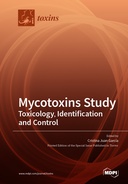Explore

Mycotoxins Study: Toxicology, Identification and Control
0 Ungluers have
Faved this Work
Login to Fave
This Book of Toxins comprises 11 original contributions and one review. New findings regarding presence of mycotoxins in aromatic and medicinal plants, mango and orange juice, juices, pulps, jams, and beer, from Morocco, Pakistan, and Portugal are reported. In these studies, innovative techniques to study their presence has been developed, including liquid chromatography coupled with time-of-flight mass spectrometry to analyse mycotoxins and conjugated mycotoxins. Novel strategies to detect mycotoxin presence and comparisons the characteristics of a rapid quantitative analysis of different mycotoxins (deoxynivalenol, ochratoxin A, patulin, sterigmatocystin, and zearalenone) are also presented using acetyl- and butyrylcholinesterases and photobacterial strains of luminescent cells. Additionally, toxicological effects of zearalenone metabolites and beauvericin on SH-SY5Y neuronal cells are presented. One important point in the control of mycotoxins is related to decontaminated strategies, and in this sense the efficacy of potentially probiotic fruit-derived Lactobacillus isolates in removing aflatoxin M1 (AFM1) is presented. Other mycotoxin decontaminated techniques included in this book are electron beam irradiation (EBI) and degradation of zearalenone and ochratoxin A using ozone. Finally, a review that summarizes the newly discovered macrocyclic trichothecenes and their bioactivities over the last decade is included.The evaluation of the presence of mycotoxins in different matrices is achieved through different analytical tools (including quantitative or qualitative determinations). Studies of mycotoxin isolation, using chromatographyc equipment coupled to spectrometry detectors (QTrap-MS/MS, MS/MS tandem, QTOF-MS/MS), are the most useful tools to control their presence. All these studies represent key steps in the establishment of the limits of detection, limits of quantification, points of identification, accuracy, reproducibility, and repeatability of different procedures. The maximum permitted or recommended levels for mycotoxins in different matrices are within a wide range (including the levels tolerated by infants and animals). In addition, decontaminated strategies, as well as control and evaluation of exposure, are demanded by authorities and food safety systems.
This book is included in DOAB.
Why read this book? Have your say.
You must be logged in to comment.
Rights Information
Are you the author or publisher of this work? If so, you can claim it as yours by registering as an Unglue.it rights holder.Downloads
This work has been downloaded 100 times via unglue.it ebook links.
- 100 - pdf (CC BY) at Unglue.it.
Keywords
- acetamiprid accumulation
- aflatoxin M1
- analytical characteristics
- beauvericin
- beer
- binding
- binding protein
- bioactivities
- bioluminescent bacteria
- biomonitoring
- BmArgRS
- BmLamin-C
- Bombyx mori
- chitosan
- cholinesterase-based analysis
- co-occurrence
- degradation
- Destruxins
- Detoxification
- electron beam irradiation
- Enniatin B1
- entomopathogens
- enzymatic detoxification
- exposure
- food safety
- fruit-derived products
- High Resolution Mass Spectrometry (HRMS)
- human risk assessment
- immobilized cells
- immunoaffinity clean-up
- in vivo
- insect pathogenesis
- Lactobacillus
- LC-FD
- LC-MS/MS
- macrocycle formation
- macrocyclic trichothecenes
- mango
- medicine
- metabolomics
- Morocco
- MTT
- mycoinsecticides
- Mycotoxins
- n/a
- ochratoxin A
- optimization
- orange
- ozone
- patulin
- Probiotics
- putative biosynthetic pathway
- Q-TOF-LC/MS
- qTOF–MS/MS
- regulatory limits
- RNA helicase
- secondary metabolites
- SH-SY5Y cells
- zearalenone
- zearalenone derivates
Links
DOI: 10.3390/books978-3-0365-1415-4Editions

